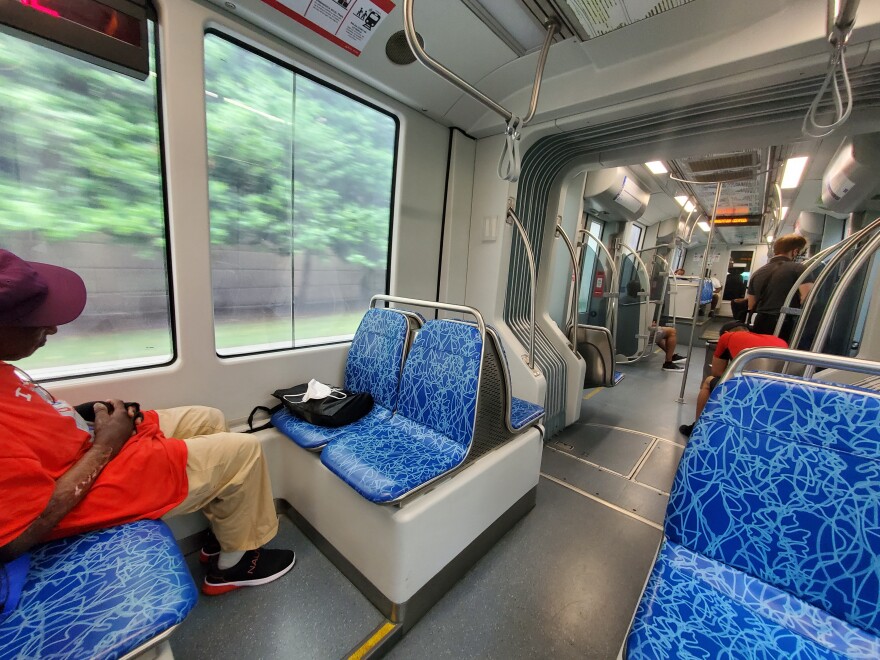In April 2019, the Charlotte Area Transit System handled 1.8 million passenger trips.
A year later, during the first full month of North Carolina's stay-at-home order as the coronavirus raged across the state, ridership fell to just under 594,000.
In April 2021, ridership started increasing again, to 721,500 trips. That’s a 21% increase from a year ago, but still down 60% from 2019.
“What we’re finding is that ridership is slowly making the climb,” said Paul Skoutelas, the chief executive of the American Public Transportation Association.
He said it may take two years for ridership to bounce back, but he’s optimistic it will happen.
Labor Day, he said, will be the true start of the recovery. That’s when corporations with large presences in the downtown areas of America's cities,– including in Charlotte, have said they will start bringing workers back to their offices.
“We’re social beings, we need to be out,” Skoutelas said. “It’s already happening. People are getting out to restaurants and retail shopping. People are eager to get back out.”
In Charlotte, there’s a lot at stake as to when riders fully come back, if they ever do.
The city wants Mecklenburg County voters to approve a 1-cent sales tax increase to help fund an $8 billion to $12 billion transportation plan known as Charlotte MOVES. Most of the money would go to a new light rail line from Matthews to the airport and possibly into Gaston County, a commuter rail line to Lake Norman and expanded bus service.
The big question: Will working from home stay around?
If office workers are only in the office three days a week, that doesn't just mean they aren’t riding transit two days a week, said Steve Polzin, who was a senior advisor in the U.S. Department of Transportation in the Trump administration.
“If the roads are less congested, then you are more likely to drive,” Polzin said. “If there’s less competition for parking spaces that will certainly incent people to drive.”

He said that post-pandemic, the share of people working from home could double or triple to around 15% of the workforce.
“There’s even some speculation that these changes will incent people to move even further away and be willing to commute longer because they are only doing it a few days a week,” Polzin said. “Which might mean (people are) moving beyond traditional market areas for transit into areas of lower density. There’s certainly some evidence of that happening as well.”
Ron Tober was the first chief executive of CATS. He is one of Charlotte’s biggest transit advocates, but even he’s concerned about the impact of people working from home.
“You know, a lot of places are talking about going back into the office this fall,” Tober said. “Is a year enough time to see how that commute pattern settles out, how much red do you see on the freeway in the afternoon rush hour? I don’t know.”
When Tober was interviewed in May, Duke Energy had recently announced it was shrinking its total office space footprint in Charlotteby 60%, in part because some employees would have hybrid work schedules.
Tober said delaying the Charlotte MOVES plan was “not (his) preference.”
But, he added: “Frankly I’d be hard-pressed to argue against that.”
The 86-page Charlotte MOVES plan was released in December, nine months after the pandemic began. The work-from-home trend is mentioned once in the report, but without any projection or thought as to whether people might do it more in the future.
Earlier this year, when the Charlotte MOVES plan was on the front-burner, there was little talk about what post-pandemic commuting would be like. Because Charlotte is growing so fast, many City Council members, like Malcolm Graham, believe transit is needed regardless of what happens with people working from home.
"Notwithstanding where we are today in terms of the data, the data also suggests that more people are moving to our community and we will have to provide a viable option other than cars for people to get around," Graham said.
Michael Smith of Center City Partners said the city should move quickly to implement Charlotte MOVES.
“We should not pause for a second on our aspirations for the 2030 transit plan,” Smith said. “I can tell you that when we meet with economic development prospects it is a key differentiator like our airport is. It is the same kind of asset.”
If you look at transit ridership in Charlotte, there have really been two crises.
The first was from 2014 to 2019.
That’s when ridership dropped by nearly 20% – despite CATS opening the $1.1 billion LYNX Blue Line extension in 2018. During that period, the bus system saw the biggest declines in traffic, possibly due to people turning to ride-share services or buying their own cars.
Then came COVID-19.
In Charlotte, ridership on regional express buses for commuters was almost entirely wiped out, down 90%.
Ridership on light rail, which also relies on commuters, is down nearly 70%. Local bus service, which serves essential workers, is only down by half.
Polzin says the pandemic may make transit systems focus less on choice riders who may now be working from home a few days a week.
“We’ve been chasing the choice riders (with light-rail) and in the meantime, we’ve been cutting bus service and not helping those market segments that really need transit,” he said.
Charlotte hoped to put the transit tax on the November ballot, but a delay with population data from the U.S. Census Bureau means that vote can’t happen until 2022.



